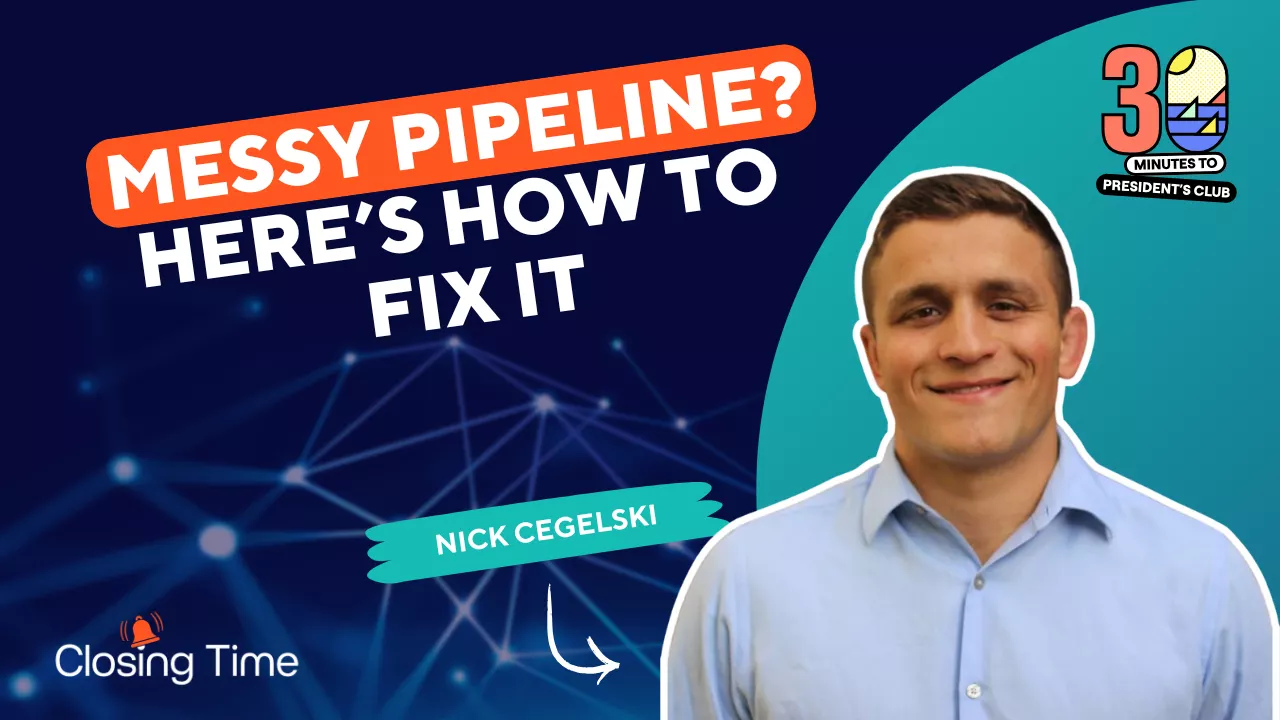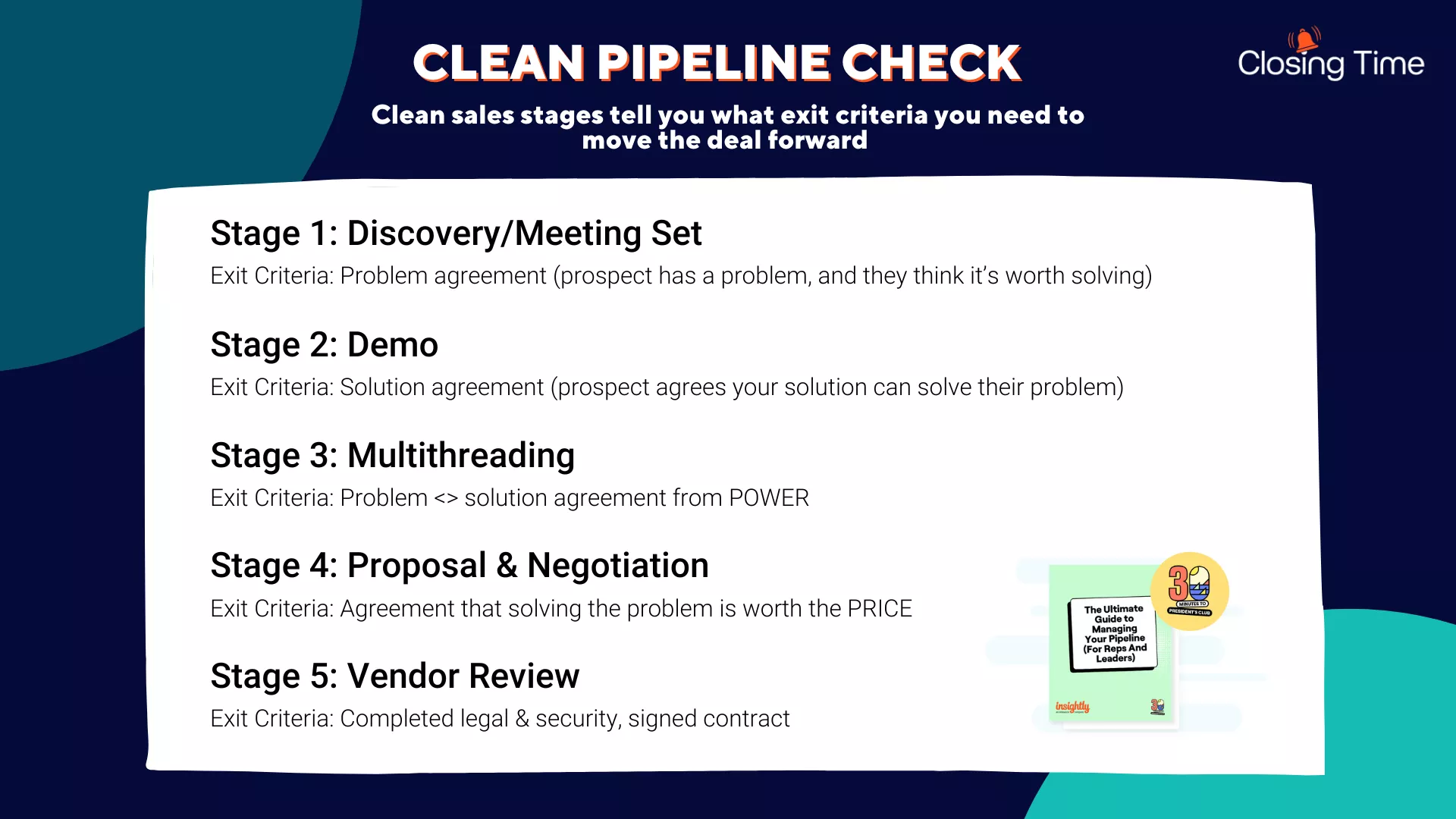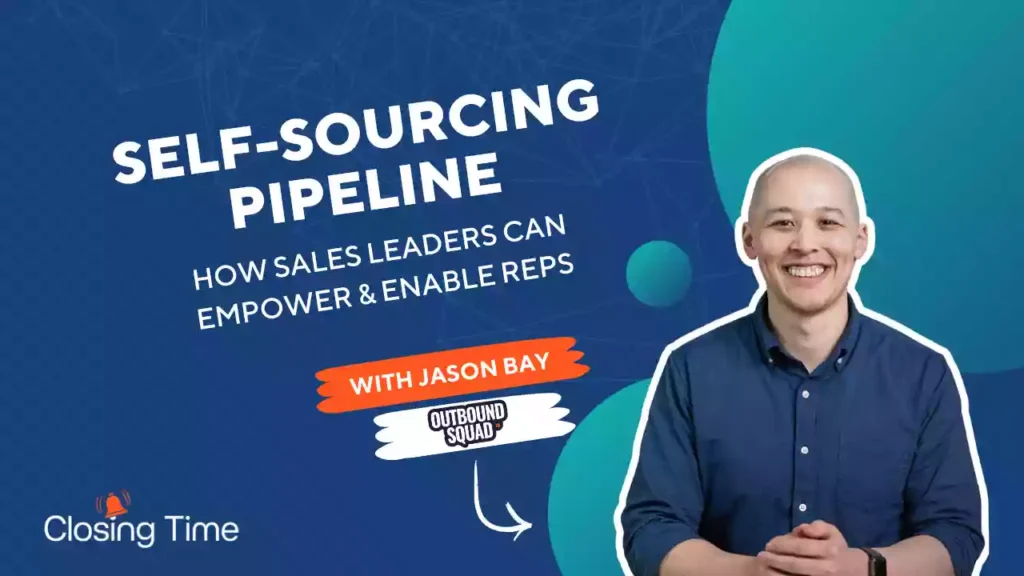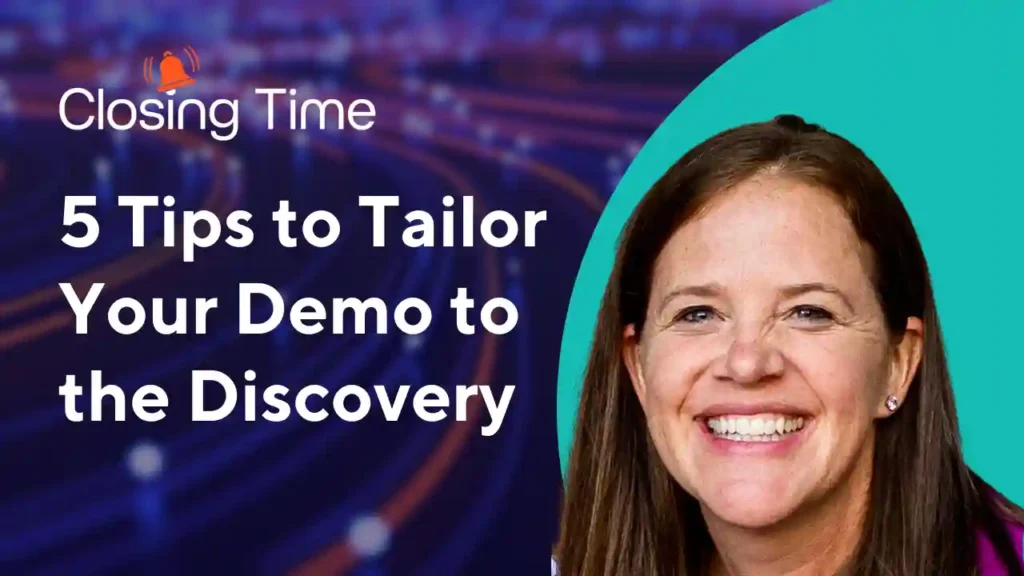Show me a clean pipeline and I’ll show you a successful sales executive.
So let’s talk about tactics for pipeline hygiene, both for sales
reps and sales leaders.
In this episode of Closing Time.
Thanks for tuning in to Closing Time, the show for go to market Leaders.
I’m Geoff Coutts,. SVP of sales and customer operations
for Unbounce, Insightly and LeadsRX.
Today I’m joined by Nick Cegelski.
Nick is a sales coach, the author of Cold Calling Sucks
and CEO of 30 Minutes to Presidents Club.
Thanks for joining us, Nick.
Well, thank you for having me here, Geoff.
I’m really excited.
I also have a co-founder at 30 Minutes to President’s Club, who,
I don’t want to take all the credit for running it, but,
I’m excited for this conversation.
Okay. So, Nick, let’s jump right in.
Under normal circumstances, we know that if you look across the industry,
some percentage, let’s say call it 60, 70, 80% of your sales reps
should be hitting quota on an annual basis.
But the last two years have been anything but normal.
You contend that pipeline hygiene is key to success
and being on the right side of that statistic.
How do you feel about that?
My response to that is as follows.
Having a clean pipeline should not be a distraction
from talking to or getting in front of customers.
However, the way that your pipeline shows up dictates
how you talk to and show up and get in front of customers.
What I mean by that is,
if I don’t have a sense of where a prospective customer
is in the buying journey, and I think about the buying journey
not based on what meetings have. I had with them, but I think about exit
criteria for different stages of somebody buying something.
If somebody is not yet bought in that they have a problem
that is worth solving yet,
I’m going to approach my conversations with them very, very differently
than someone who agrees that they have a pressing problem that needs to be solved.
Feels like our solution is probably the right one to solve it,
but we need to get their boss or their boss’s boss bought in.
Those are really, really different motions that I’m running,
and if I don’t know where
each deal in my pipeline is, there are different plays that I run.
Deal by deal by deal, based upon where it actually is in that buying journey.
But if I don’t have a handle on like
where all 43 deals that I’m working right now are,
I’m going to have to rely on my memory and my gut, and
I’m going to burn a lot of really, really valuable mental calories
thinking about and scanning
my mental Rolodex of like, all right, where is this deal?
What happened last? What play do I run?
And so I don’t think being a CRM, fanatic and making sure
every single moment of the day, it is perfectly updated like
that can be a distraction.
But I think there is no excuse to at least once a day going through
looking at your business and figuring out great, where are things right now?
What is the state of the Union, and what are the different plays
that I need to run with each individual deal in order to progress this?
That’s how I would think about things as a as a rep, as a leader
having a clean pipeline.
Like, frankly, I need that to be able to understand where is there
unnecessary friction in our deal cycle where I can find ways to remove friction?
Where are the places that my team is struggling?
And this is how I start to sell in a way that or this is how I coach my team
in a way that allows us to pull on the biggest levers.
Otherwise, I’m just guessing.
And so, to summarize,
a clean pipe should not be a distraction from doing the hard work of selling,
picking up the phone, making cold calls, meeting with prospective customers, etc.
but it should be something that once a day. I use to find out
what’s the state of my business,
which informs my game plan for the next day.
I love that thinking.
Especially the comment that really,. I think you’re
talking about business impact up front and understanding,
to what extent we know that deal by deal so that we know what stage we’re at.
So I think it’s great advice.
Maybe just a bit of a reality check.
Some account reps and managers,
frankly, spend only, you know, a couple of minutes
before a pipeline meeting preparing for it and getting their hygiene up to snuff.
What are what are some of the ways that you might suggest to convince sales
reps that pipeline hygiene is something that’s ongoing and they should be doing?
Okay, so if I were trying to convince a rep that their pipeline
hygiene is worth doing,. I would think about 2 or 3 things.
Thing number one is. I look like a total buffoon.
If I show up to a meeting with my manager and my pipeline is not clean.
That’s part of the job.
This is part of, like,
what your manager, what your boss needs in order to do their job.
And irrespective of like it mattering to you, let’s say it doesn’t
didn’t matter to you at all.
If it matters to your boss and it matters to your boss’s boss.
If you want to move up in your career, take the 30 minutes before the meeting
and make sure that this thing is super, super clean.
So like that’s piece one.
Piece two, it goes back to what I said earlier,
which is you should be using your pipe and updating your pipeline as a mechanism
to help you have a handle on your business,
to help you decide where you need to spend your time.
In practice, what this actually should look like
is, as a rep, at the end of the day,. I’m doing a pipeline scrub.
When I’m doing my admin time, that’s when I’m sending my recap emails.
That’s when I’m clearing out my inbox and doing all of like the non selling stuff.
I’m clearing stuff out and I’m doing a really quick pipeline scrub.
And frankly, if I’m doing this every single day,
a saying that I have is, it’s really, really hard to get in shape.
It is much, much easier to stay in shape.
And what I mean by that is if I get my pipeline clean, I’ve got the closed
dates, right, I’ve got the deal stages right, I’ve got clean
next steps that are coded in a way that help me understand what I need to do.
The deal values are right.
It takes some effort to get that done right once.
It’s probably going to take me an hour, maybe two
if it’s like really, really messy and not up to date.
But once I get everything in shape, it doesn’t take me more than ten minutes a day.
And now what I can do is pre-meeting
I can take, this is what I would do as a rep.
I would take your time.
I would make sure that it’s super clean,
and then
I can spend the meeting with my manager strategizing on how to drive deals forward
rather than being like, oh shoot, that one’s coming in in February, not January.
That’s a waste of everybody’s time.
If I’m working on hygiene.
So I’ll pause.
You may have questions or thoughts.. No. That’s great.
I love the advice.
I think there’s two pieces there.
There’s overall career advice, I heard, if you want to advance in your career.
And number two is, if you make it a habit, it becomes easier, right?
You don’t have to worry about it all the time.
It just becomes something that you do.
So really good thoughts there.
Our teams, have partnered to produce what we call
the ultimate guide to managing your pipeline.
Let’s maybe review some of the key points in that starting
with the daily pipeline checks.
What does that look like inside a sales organization?
Would you recommend?
Yeah.
I don’t think it’s much different than what I said earlier,
which is end of the day when I’m doing my admin time.
Hopefully. I’ve talked to some customers that day
and hopefully it’s pretty fresh for me that like.
Oh yeah, okay.
I talked to Geoff’s team.
They, you know, they’re bringing on a new head of enablement
and they’re not going to be doing anything until March.
And I know that the deal
is not going to get touched until March, but I have it as a January closed date
that’s in my head.. And that tells me, great. Okay.
Probably need to update that closed date,
and I’m doing that for each of my deals.
I’m figuring out what happened with every single customer that I talked to today,
and how does that impact what I need to do to update the pipeline?
I can get that done in ten minutes because everything’s fresh.
If I’m waiting to the end of the week, or if I’m waiting to the end of the month
to update things,
now I’ve got to go back and be like, what did he say in that last email?
I now have to go listen to the call recording.
It’s actually a lot harder.
So for me, ten minutes a day keeps things clean.
I’m sure I could make some joke about an apple a day.
Keeps the sales manager a day and make some dumb analogy.
I won’t do that, but I would say a ten minute scrub at the end of the day
makes it much, much easier to keep things in shape.
Okay, I think. I think that’s a really good comment.
If I extend that maybe just a little bit further.
So that’s talking about how to spend your time.
Doing the sales, the the CRM, hygiene.
Let’s talk
about using the pipeline checks, then to figure out where to spend your time.
Can you expand on that notion a little bit?
I think it’s you touch on it in the guide, but maybe you can make a few comments.
So in order to properly answer this question,
I want to talk about the paradigm of like,. I think it’s important to to to lay out
the foundation of sales stages
that are based on exit criteria
rather than meeting based sales stages.
And what I mean by that is I talk to a lot of sales orgs
where their deals move to different stages
based on the types of meetings that I’ve had.
Just because I’ve shown you pricing,. Geoff, doesn’t mean that we automatically
jumped ourself all the way to the proposal and negotiation stage.
If you’re not bought in on like, is this the right solution yet?
Now, that doesn’t mean that I won’t do those things in different orders,
but I think a lot of sales orgs trip themselves up by thinking that
a deal progresses, just because I’ve had certain meetings with a prospect.
Meetings, demos, proposal calls, pricing conversations
are all mechanisms to move deals through exit criteria stages.
For me, the exit criteria and frankly, for a lot of sales
orgs, the way. I think they should think about
their sales stages is stage one is simply problem agreement.
Can we get the customer to say, I have this problem and I think it’s worth solving?
Stage two would be solution agreement.
I have this problem.
I think it’s worth solving.
And Nick,
I think your solution is the right solution
to solve this thing or one of the best solutions to solve this thing.
It adequately solves that problem that I believe we need to solve.
The next stage would be power problem into solution agreement,
meaning most deals, unfortunately, Geoff,
if I’m selling to to your org, I’m probably not talking to you first.
I’m probably talking to somebody that reports up into you and I.
In order to get to you,
they need to believe that they have a problem we’re solving
and that our product can help solve that problem.
Once I’ve exited that stage, then I’m moving to agreement on commercial terms.
Meaning we have a problem we’re solving solution is the right one to solve it.
Power agrees to it
at a price that we feel like, and not just price, but full commercials.
We feel like it’s fair.
And then the last stage is full vendor agreement,
meaning we have to go through things like security, legal, etc.
and when I’ve exited that stage, the exit criteria for that stages,
we have a closed one deal.
The reason that that foundation is important is what that allows me to do is
if I know where a deal is, if I know that they’ve agreed to a problem,
but have not yet agreed to, this is the solution to solve it,
I can now scan through my playbook, my checklist of all the different ways
that my org can get somebody to say, you know what?
This solution is the right one to solve this problem.
The most common for that is like showing a demo,
but there’s other ways I can do that.
Also, I could have them talk with a reference customer.
I could do a POC,. I could get a copy of some of their data
running analysis and show them like a bespoke report
that we could create that would really, really help them.
We did that a lot when I sold ERP systems to law firms,
but if I don’t know where my deals are from, an exit criteria, stage perspective,
it’s really, really hard for me to figure out what plays I run to progress
the deal.
So I’m going to pause.
I just monologue at you for five minutes straight. You have.
You might want to ask a question about that.
And then I can talk about like, okay, what does this look like
in the rhythm of working my deals and driving them forward?
Yeah. No.
I think those are great comments.
When I hear you, you say those things,. Nick, I think about the flow
and the natural progression.
And you’re thinking about it from sales stage to sales stage.
And it’s not activity driven.
But what I’m hearing is outcome driven.
So what outcome do you need to drive at the end of that sales stage?
I almost think about it is,
you know, start with the end in mind, but by by sales stage,
what do you need to do for that exit criteria?
I really like that.
What was the next thought you had to follow up on that? Yeah.
And so again. I don’t mistake activity for achievement
just because I had an activity,
just because I had a meeting does not mean that I achieve that outcome.
And that’s the reality sometimes of selling.
It’s like Geoff. I might sit down with you and say great,
we’re in, we’re in the stage where we’re trying to get solution agreement,
and I might meet with you and show you a demo.
And at the end you’re like, yeah,. I feel good about this demo,
but you didn’t show me these three modules,
or I want to go a little bit deeper on your analytics
dashboards to feel like this is right.
I’m still in that same stage.
Just because I showed you a demo doesn’t mean that I’ve exited that demo stage.
We still have more work to do,
and so when I reorient around exit criteria instead of meeting based stages,
it allows me to be a lot more focused on what is the next thing that I can do?
What is the next best action related to this deal, to drive it forward?
The other power of this is when I shift to exit criteria based stages.
It allows me to more effectively.
It changes the paradigm for a sales org to how they will sell in between meetings
because deals get done, not just in meetings, but in between those meetings.
And so now I can sell in between meetings.
If I have a demo scheduled with you next week.
Geoff, there’s probably things that I can do between now and that meeting
to help increase my ability to move through the stages.
Maybe I call somebody on your team that you mentioned in a in a past meeting.
Maybe I get in touch with your IT team and say, hey,
maybe we can accelerate the, the IT side of this.
Maybe I go meet with one of your peers.
Maybe I send you a case study.
Maybe I send you a short video where we’re like, hey, Geoff,
you know, we had a great meeting last week about our analytics dashboards.
I know we’re going to go way deeper
next Friday, but I filmed the three minute loom video video for you,
showing you a preview that answers some of the questions that I know you had.
There’s lots of things. I can do in between meetings
to help move and progress that exit criteria.
When I have these stages now, every single day, here’s what I’m doing.
I’m pulling up my pipeline.
I’m looking at the deals, and. I am thinking about what can I do today
to help progress each of these deals.
Sometimes it’s nothing. Sometimes it’s like, nope, I’m all prepped.
We’ve got a demo next Friday.
I’ve done everything that I can do. Great.
What about the 22 other deals?
I’m sure there is something that I can do to progress that deal.
And so that is the paradigm flip of how you think about moving that pipe forward.
I’m with you all the way.
I think what that’s leading me to think about is one of the tools
in the guide we talked about is is just around that.
What are all the things I need to do?
And so there’s a there’s a tool called a walk-back plan.
Can you, we use something like that internally in my organization
we get a lot of value out of it.
I think it’s pretty powerful to help from a forecasting standpoint.
Can you tell us just a little bit about how you think about that document,
how it can be used?
So let’s just first talk through like what a walk-back plan even means.
The first thing to think about is what does your prospect
actually care about?
Your prospect does not care about signing a contract.
Your prospect cares about solving their problem.
And so when I’m talking about
buying my product with my prospect,
I’m not talking about, all right, when is this deal going to close?
I’m talking with the prospect about like,
when do we need to get this problem solved for you?
And then what. I’m doing is I’m able to say, great,
if you are telling me that June 30th is when your current contract
with your provider expires, and that’s when you need something new in place,
they can’t sign the contract with us on June 30th,
because we’re not going to be able to implement in zero days.
I need to think about what are all the things
that need to happen for the prospect between now
and when they need something in place or want something in place?
There’s not always a hard deadline like that that need to happen
in order to get us live and get their problem solved.
Signing a contract is just one of those things,
and so what I need to surface to the prospect is one I need to have.
Honestly, I need to have honest, frank, open, truthful conversations with them
around like realistically, like when are you wanting this thing to be live now?
They’ll sometimes know.
Sometimes it’s on us to help suggest or teach them why it might be
in their interest to get this thing live in, May instead of June.
But assuming we’ve had a conversation with the prospect about
this is when we want this thing in place, what I can now do
is I can say great implementation period is going to take six weeks.
Your kickoff call, getting that scheduled, it’s going to take ten days.
We’ve got a ton of customers in the queue, so it’s going to take a while.
So realistically it’s going to take two months
from when a contract is signed to when you’re live on this thing.
So now that’s out.
That’s out there.
If June is when you need this live,
okay, April is the latest we would need to have something signed.
It’s January right now.
Let’s talk about now what are the things that need to happen
between now and April when the contract needs to be signed in order
for you to feel like this thing is right and now I can start to work back.
Legal review, IT review.
They might want to talk with a reference customer.
Who else needs to see a demo of this thing, or have a conversation
about how this might work out?
And now what I can start to do is I build a project plan for
we need to
have a contract signed by this date so we can have the implementation period.
So you can be live.
And that helps me manage to the forecasted close date
rather than just saying. I think it’s going to come in in May.
I think it’s so smart.
You know, I think about,
as you’re saying, that one of the struggles
people have is to identify a compelling event.
Right?
So if you can identify
the compelling event, in this case,. I want to be live by X or not replace Y.
Then that helps you anchor a destination point.
So I really like to think a lot.
Neck. Thanks so much.
I think there’s a lot of value in what we talked about today.
If anybody out there is looking for a copy
of what we’re talking about, the ultimate guide
to managing your pipeline, you have an ability to to download that.
If you visit insightly.com/30mpc, we’ll put that link in the show notes.
Nick, I want to thank you so much for joining us today on Closing Time.
If I were to ask you, where can people get more information
about the 30 Minutes to Presidents. Club community, what would you recommend?
You can follow me on LinkedIn.
My first name is Nick.
My last name is C-e-g-e-l-s-k-i, and I accept every LinkedIn request
provided you don’t put something really, really weird in the connection thing.
Like, hey, are you looking for more leads?
I get a lot of those weird ones.
I used to get people trying to sell me. Bitcoin quite a bit,
which was always interesting, but, yeah, LinkedIn is fine.
Or you can go to 30mpc.com.
That’s great.
That’s probably good advice for all of our listeners.
And thanks, everybody for tuning in.
Please feel free to sign up for the Closing Time newsletter
to get this show delivered to your inbox on a regular basis.
And you can click, the show notes right now.
You’ll also find clips to insightly social channels in there.
So, thanks very much for joining today, and we’ll see you next
time on closing Time.





